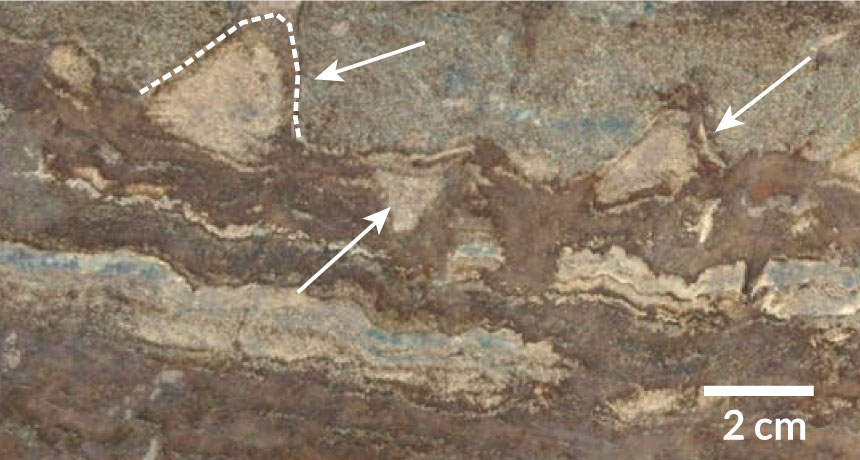
PERPLEXING PEAKS In 2016, scientists suggested these small mounds (arrows, one outlined by a dashed line) were stromatolites formed by microbes 3.7 billion years ago, but a new study suggests they were formed by tectonic forces.
A.C. Allwood et al/Nature 2018
Tiny mounds touted as the earliest fossilized evidence of life on Earth may just be twisted rock.
Found in 3.7-billion-year-old rocks in Greenland, the mounds strongly resemble cone-shaped microbial mats called stromatolites, researchers reported in 2016. But a new analysis of the shape, internal layers and chemistry of the structures suggests that the mounds weren’t shaped by microbes but by tectonic activity. The new work, led by astrobiologist Abigail Allwood of NASA’s Jet Propulsion Laboratory in Pasadena, Calif., was published online October 17 in Nature.
The further back in time you go, the more devilishly difficult it is to identify signs of life. Allwood herself is familiar with the skepticism that comes with making such a big claim: In 2006, she and colleagues suggested that 3.45-billion-year-old rock features found in Australia’s Strelley Pool Chert were stromatolites. Though that claim was met with skepticism initially, a growing body of research has ultimately supported it.
Then, in a 2016 paper in Nature, geologist Allen Nutman of the University of Wollongong in Australia and colleagues reported finding a series of reddish mounds within a group of ancient Greenland rocks known as the Isua supracrustal belt. Most of the belt has been twisted over time by tectonic forces. But Nutman and colleagues discovered the mounds within a portion of the belt that appears relatively unaltered, and the team presented numerous lines of evidence suggesting the structures were actually stromatolites (SN: 10/1/16, p. 7). If true, the discovery would push back the date of the earliest fossilized evidence of life by some 250 million years.
But that study, too, has been met with skepticism, including from Allwood. “The evidence that was presented was robust,” she says. “But there were a couple of things about the structures that seemed odd.” For one thing, stromatolites would all grow upward from the seafloor, forming cones that point in one direction. But one of the cone-shaped structures in the 2016 study was, curiously, oriented downward.
So Allwood took a closer look, traveling to Greenland in September 2016 to study the outcrops featuring the structures. With Greenland’s permission, Allwood’s team cut a chunk of rock off the end of one of the two sites where the structures had been found. “We took a slightly bigger sample than Nutman had taken,” she says. “That was a good thing, because it provided the context that gave us the answer.”
That sample gave a more three-dimensional picture of one of the structures. Although cone-shaped when viewed from one side, from a different angle the structure was flatter, more like a ridge than a cone. That’s significant, Allwood says. Cones “are difficult to produce by anything other than biology. If it’s an elongate ridge, it’s no longer in that special category.”
Her team analyzed several other lines of evidence that could point to a stromatolite, including internal layers, chemical composition and the environment in which the mounds probably formed. Stromatolites are mats that build slowly in shallow marine environments as marine algae secrete layer after layer of carbonate-rich sediment.
But the new structural and chemical analyses of the fine layers within the Greenland structures suggest that the layers are actually chemical alteration fronts. The fronts, Allwood’s team says, were produced by the gradual reaction of carbon-rich fluids circulating in the silicate-rich rock, part of the long history of tectonic alteration in this belt. “It’s like taking a piece of sponge cake, dropping it in alcohol and watching it change from the outside in,” Allwood says.
In addition, rocks surrounding the structures show signs of metamorphic deformation, changes in rock such as minor folds and cleavage caused by heat and pressure. In the end, Allwood’s team concluded that the structures probably formed tectonically rather than biologically.
Nutman and his colleagues stand by their interpretation. In an e-mail, Nutman suggested that the sample collected by Allwood’s team was not representative of the other structures: The sample appeared at the edge of one of the two outcrop sites described in the original study — a location that was more tectonically altered than the other parts of the site. “This is a classic comparing apples and oranges scenario,” Nutman wrote.
Mark van Zuilen, a geomicrobiologist at the Institut de Physique du Globe de Paris who has studied the Isua supracrustal belt, says that when the 2016 paper came out, he was excited. But he also wondered about deformation features in the rocks. The new study reveals “clear signs of deformation,” says van Zuilen, who wrote a commentary accompanying the new study. “The big trouble is that these rocks are so old and metamorphosed. They have been completely recrystallized and deformed under high pressure and high temperature,” he says. “This means we are always sorting out what features of the rock are primary, and what features were caused at a later stage.”
Nutman and colleagues’ discovery is so recent, van Zuilen notes, that few scientists have had a chance to see the structures. Future research may help clear up how the structures formed, he says.
The debate highlights how important it will be to understand as much as possible about the geologic setting of a future Mars landing site, if scientists hope to spy evidence that there was once life there. It’s hard enough to collect follow-up samples to ascertain signs of ancient life in remote parts of Earth like Greenland, says Allwood, who was at a NASA workshop the week of October 15 to discuss potential landing sites for the Mars 2020 rover mission. “But you can’t arrive on Mars with no clue of what you’re looking at and then say, ‘Oh, we’ll work out the details when we get there,’” she says. “If you do that, you’re setting yourself up for failure.”






